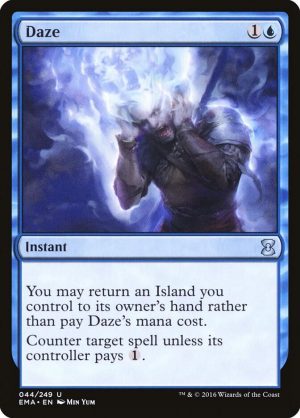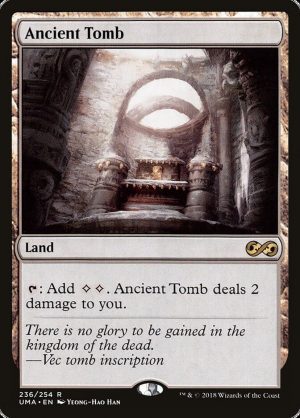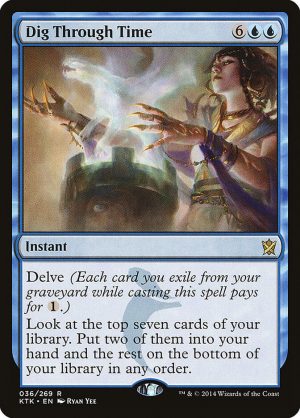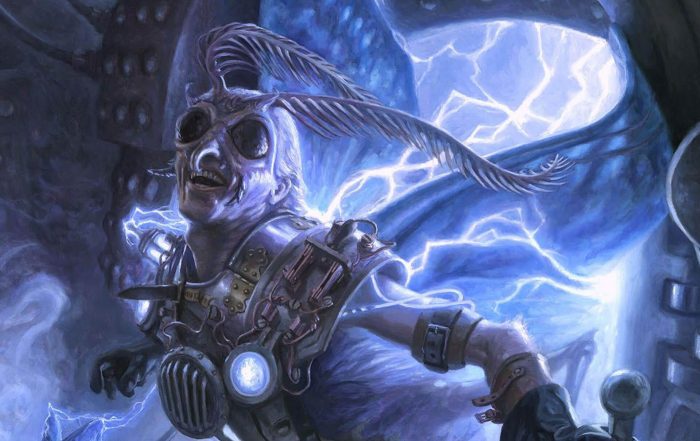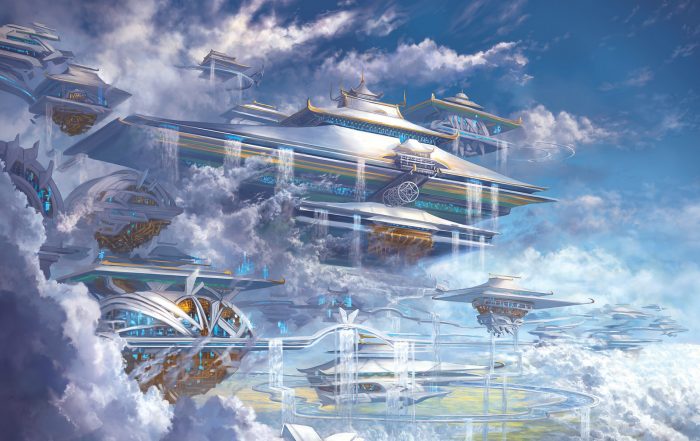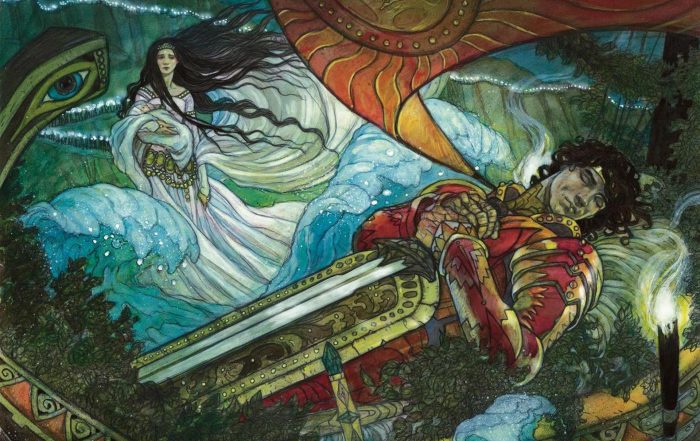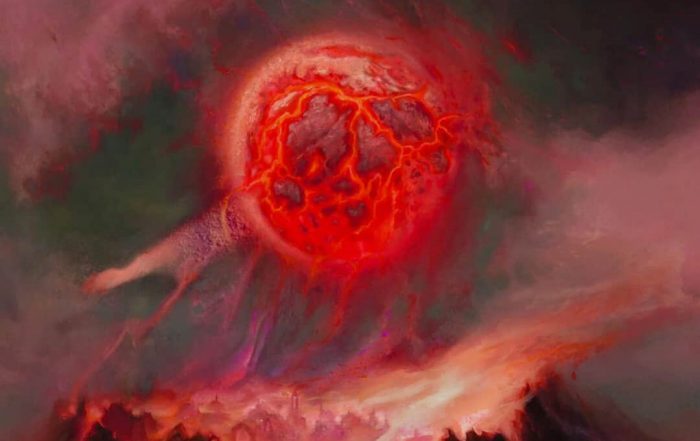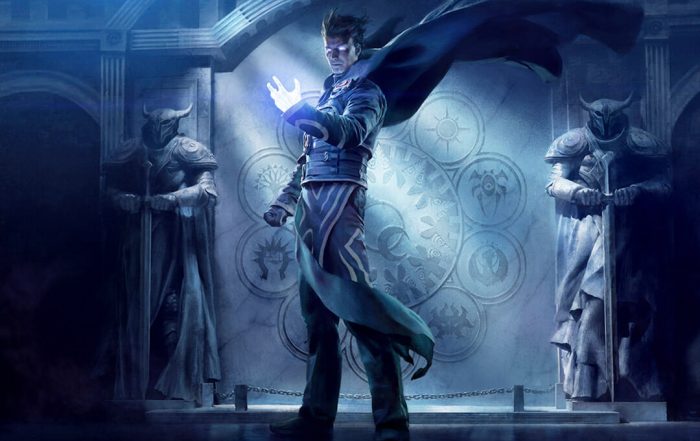Legacy Ban Analysis
March 2023
Expressive Iteration and White Plume Adventurer are gone from Legacy
An Analysis on the March 2023 Legacy Bans
Author: Sven Stolz
On March 06, Wizards of the Coast decided to ban Expressive Iteration and White Plume Adventurer in Legacy. In the following article, we will revisit and analyze the Bans & Restrictions announcement in context of previous bans and take a closer look at the Delver tempo archetype.
B&R announcement, March 06, 2023:
Since the last update, the Legacy metagame has evolved such that two major archetypes combine to make up a large portion of the field. These are the perennially popular Izzet Delver and the recently enabled Mono-White Initiative. With their combined presence approaching 30% of the field in some circles of competitive play, we’re choosing to ban one card from each deck to lower their respective win rates and metagame shares.
Two Decks, One Format
For the last couple of months, Legacy’s metagame was mainly dominated by two major decks, Izzet Delver and Mono White Initiative. With Legacy’s large card pool and variety of different decks and archetypes, the format was in a rather unhealthy spot, consisting 30% of only two different decks.
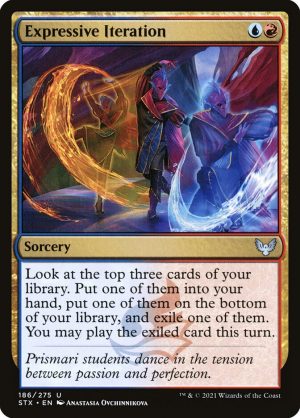
On the one side, there was Izzet Delver. While Izzet Delver already received a ban with Ragavan, Nimble Pilferer a year ago, the deck continued to perform well and stayed on top of the metagame in 2022.
Being a tempo shell and already utilizing Legacy’s strongest cards like Brainstorm, Daze and Wasteland, the deck received further upgrades in threats and card advantage pieces with Dragon’s Rage Channeler, Murktide Regent and Expressive Iteration over the last two years.
On the other side, Mono White Initiative was a newly formed deck in Legacy, based on the initiative mechanic introduced in Baldur’s Gate. Initiative was used inside the stompy archetype, which exploits mana cheating cards like Ancient Tomb and City of Traitors to resolve early threats or disruption pieces on the board.
Initiative gave stompy a mechanic with continuous board effects making the deck more resilient to removal spells and enabling the deck to snowball through the game. WotC decided to act and banned Expressive Iteration and White Plume Adventurer.
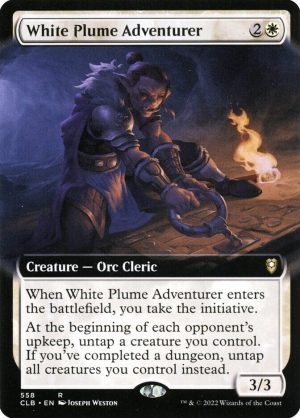
The Bans and Restrictions Announcement
B&R announcement, March 06, 2023:
While we acknowledge and agree with the many Legacy players who enjoy the play patterns of Izzet Delver and similar archetypes, our data indicates a need to take the win rate and popularity of the deck down a notch to allow for more metagame diversity and innovation. Our choice is to ban Expressive Iteration, as the card quality and quantity it provides allows Izzet Delver to easily adapt to stay on top of any changes in the metagame.
In addition to removing a generally strong card, our hope is that by removing Expressive Iteration, we reinforce Izzet Delver’s historical strengths (efficient one-for-one exchanges) and weaknesses (lack of sources of card quantity) in a way that leaves the deck more vulnerable in the metagame.


When analyzing the reasons for the ban of Expressive Iteration and White Plume Adventurer, there are two different positions I want to present in this article. Generally, when speaking about Legacy, WotC seems to recognize certain cards as so-called “fundaments” of the format.
Those consists of cards such as Brainstorm, Daze, Wasteland, Force of Will, Ancient Tomb, and others.
It looks like Legacy’s ban policy is mainly centered around preserving those fundaments for nostalgic and format identity reasons, and therefore bans primarily new cards entering the format. When evaluating which of the new cards need to be banned, WotC is analyzing win percentages, meta shares, deck diversity and other factors and indicators.
Why Expressive Iteration?
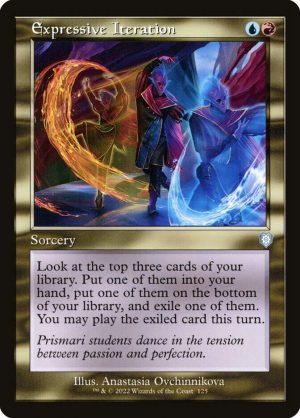
In case of Expressive Iteration, the card represented a strong card advantage spell both blue control and tempo used to their advantage to consistently dig through their library and stay ahead of the game by the continuous 2 for 1 effect. Guaranteeing to not run out of Expressive Iterations, it was used in combination with Mystic Sanctuary which improved top decks dramatically and increased previously mentioned effects further, making Delver the best tempo and midrange deck to beat.
Although Expressive Iteration is inferior to a card like Brainstorm and much below the power level of cards like Treasure Cruise or Dig Through Time, Expressive Iteration was still the second-best thing to do and pushed specifically Izzet Delver a little over the top. Therefore, WotC decided to ban Expressive Iteration, removing a high-quality card from the format for metagame diversity and archetype innovation.
On the other hand, Expressive Iteration had fundamental deck building- and power level restrictions. Instead of just drawing 2 out of 3 cards (the way a lot of players perceived the card), Expressive Iteration forced the player to make a proactive play. Because of that clause, the card was earliest used a turn 3 value play, either looking for a land or another one mana card to be played.
For Legacy, turn 3 is already quite advanced considering the various combo decks which consistently kill turn 1-2 like Reanimator, Storm, Oops all Spells and Doomsday or how impactful early disruption pieces like Wastelands, Chalice of the Void and Blood Moon are.
Because of the proactive clause, Expressive Iteration was also never played in combo decks, which is another indication that Expressive Iteration was not as abusable and powerful as cards with similar effects like Treasure Cruise or Dig Through Time, which were both played in all three archetypes (combo, tempo and control) and rightfully banned.
Obviously, a card in Izzet colors enabling the player to play more proactively, works more efficient and powerful in tempo than any other archetype. But given the nature of how well tempo performs due to Brainstorm, Daze and Wasteland, this phenomenon applies to most cards with mana value 3 or less.
For Legacy specifically, threats need to be 4 mana at least to consistently perform better in control than tempo like Jace, the Mind Sculptor, Minsc & Boo, Timeless Heroes and Uro, Titan of Nature’s Wrath. Although Expressive Iteration was a high-quality card advantage engine and gave Delver a dedicated midrange plan in addition to the tempo game, Legacy lies on even stronger format fundaments.
One may argue that it shouldn’t really come as a surprise, that new powerful cards are consistently pushing the power level of blue decks to atrocity when those are already right at edge due to Brainstorm and Daze in the first place.
The Influence of Deathrite Shaman
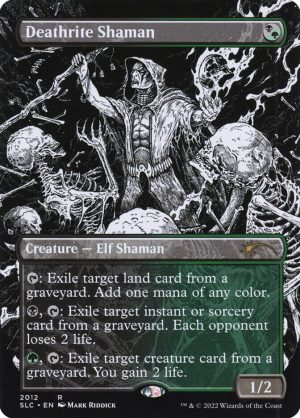
In addition, of mentioning Expressive Iteration’s format impact, WotC also states they’re trying to reinforce Delver’s weakness in a lack of reproducing card quantity and strengths in one-for-one exchanges. As someone who is playing Delver since its printing in 2011, this is kind of an odd take, because it only refers to a smaller part of Delver’s format history.
Over the years, Delver used various cards and went through different forms and variations as a tempo deck. When looking more closely and trying to establish a historical framework for Delver, the deck can roughly been split at the middle in a Deathrite Shaman and non-Deathrite Shaman era of builds.
Deathrite Shaman was printed in 2012 and became Legacy’s absolute best creature until it’s banning in July 2018. Deathrite Shaman did just everything you could have thought of in generating mana advantage early turns, killing your opponent without even using the combat and stabilizing the board and your own life.
While all mentioned abilities were already rather absurd for a one drop, Deathrite Shaman was able to interact with your opponent’s graveyard as well.
Being the most important clause when talking about Deathrite Shaman, the card was a combination of a threat and preboard hate piece, interacting with Griselbrand and Life from the Loam of opposing strategies such as Reanimator and Lands, making it an absolute monster of a card by giving fair blue tons of angles navigating through their bad preboard matchups and even reducing graveyard dedicated sideboard slots.
In addition, playing with Legacy’s most brutal one drop, Gitaxian Probe, a complete failure of card design, a card which literally should have never been printed in history of the game, was still legal, leaving up Delver as a 56 cards deck playing with perfect information the entire time.
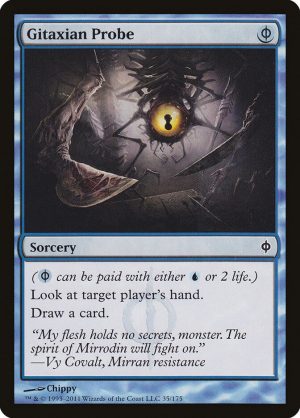
While Grixis Delver was a strict “one-for-one exchange” deck during the Shaman era (except when Treasure Cruise was legal), I highly doubt that WotC is referring to that particular time.
Sure, until the ban of Sensei’s Divining Top in 2017, Top Miracles was arguably the best deck, only loosing when Treasure Cruise became a legal powerhouse for a little more than 3 months. Still, Deathrite Shaman and especially Gitaxian Probe have higher power level than Expressive Iteration, so the entire Shaman era is probably not what WotC means when trying to reinforce Delvers one-for-one exchange strengths.
The preWAR Legacy Era
After the banning of Deathrite Shaman and Gitaxian Probe in July 2018, a rather healthy Legacy format established until the release of War of the Spark in May 2019, which is often referred as “preWAR Legacy” by the community. In that period, Delver was just a tempo deck fulfilling its traditional role without the help of cards like Deathrite Shaman or Treasure Cruise.
But even in the preWAR era, a strict one-for-one exchange strategy is not precisely true when speaking about later stages of the format. In January 2019, Ravnica Allegiance introduced Pteramander and Light up the Stage, adding overall weaker but still archetype improving threats to the format. As a matter of fact, both cards helped Delver once again to reclaim its absolute top tier status in the metagame by winning the Syracuse Open, a 656 players tournament.

While Light up the Stage is obviously below the power level of Expressive Iteration and faraway of Treasure Cruise, it was that very exact same 2 for 1 approach, which pushed Delver over the top again by creating incremental card advantage, snowballing through the game and hence strongly improving unfavorable matchups like Grixis Control, Loam variations and others.
What can we conclude when we see Delver overperforming even with Light up the Stage? Was Light up the Stage a card which could have been banned in 2019? Is it Delver itself which is a problem for the format? Or does the tempo shell already lie on such strong Legacy fundaments like Brainstorm, Daze and Wasteland, that almost any card pushes the archetype into a potential tier 0 territory?
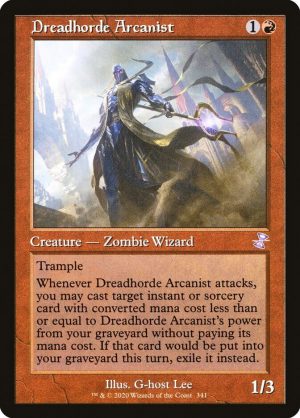
With War of the Spark and following sets, all formats entered a new era of MtG: F.I.R.E design. Legacy was overwhelmed with premium threats like Dreadhorde Arcanist, Wrenn & Six, Oko, Thief of Crowns and Lurrus of the Dream-Den; and once again Delver was the best performing deck which indirectly got all those cards banned.
Especially when coming to Dreadhorde Arcanist, one of the most controversial bans in history of the format, Delver had another threat which navigated through the game by generating card and mana advantage in recasting cantrips, the Legacy fundamentals the format seem to be all about.
B&R announcement, February 15, 2021:
Next, Dreadhorde Arcanist has proven to be powerful and game defining in a way that further adds to cards and strategies that were already among the most powerful, like Temur Delver. Without Oko, we anticipate that Dreadhorde Arcanist strategies would only become more prominent. Ultimately, the community sentiment we’ve heard is that Dreadhorde Arcanist makes gameplay revolve around it too early in the game and that too many games come down to whether an opponent can immediately remove it. Therefore, we’re choosing to ban Dreadhorde Arcanist in Legacy.
A Premature Ban
Reading carefully reveals the decision to ban Dreadhorde Arcanist was a premature take on the future metagame and was not really backed up on reliable data (yet). With the rightful ban of Oko, which was an overall horribly designed and problematic card in all formats except for Vintage, the thought process for Dreadhorde Arcanist was that it will just become the next best thing in combination with Brainstorm and Co., which eventually lead to more future “problems” in the format.
While it is extremely irritating that a 2 mana 1/3, which must untap to recast a cantrip without using mana, justifies a ban in a format of Dark Ritual, Ancient Tomb and Force of Will, Dreadhorde Arcanist was a powerful card in Legacy none of the less. While Expressive Iteration works on its own and doesn’t really need Brainstorm and Ponder to shine (see in Modern), Dreadhorde Arcanist, on the other hand, was only good because of mentioned cantrips.

My initial thoughts with Dreadhorde Arcanist were that a card, which works with the beloved fundaments of Legacy, is the bare minimum, the player base wants out of the format in the first place.
Why building an entire format on cantrips and defining them as the format’s identity, when the first thing which synergizes with cantrips is getting banned anyway?
Imagine in Modern, a format which is known for its use of shock lands, Death’s Shadow would receive a ban because it is utilizing shock lands too efficiently. While there have been states in Modern in which Shadow was the best deck, it still doesn’t sound logical to build a format on fetch- and shock lands just to ban the first card which properly synergizes with them. Of course, banning lands wouldn’t make any sense, and if Shadow was somehow problematic, it is a card which could have been banned in the past. But in Legacy, Brainstorm does not really contribute such essential deck building foundations like fetch- and dual lands for all colors and archetypes equally.
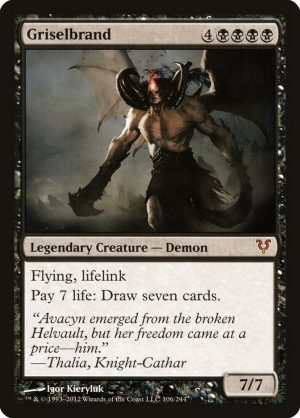
In fact, all cantrips do is to homogenize deck building and giving insane power to exclusively blue decks, making specifically Brainstorm plan A, B and C for almost any deck. A good example of that is Sneak & Show, a blue-red combo deck which wants to cheat in Griselbrand through cards like Show and Tell or Sneak Attack.
Cantrips are so strong, that the “Shell” can afford to play zero tutor effects as a pure combo deck and is still able to find the perfect mix of combo pieces, protection spells and lands on a consistent base. “The Epic Storm” (TES), a Legacy deck based on the Storm mechanic, can build an entire high-powered tier 1 deck without the necessity of cantrips but usually chooses to splash for Brainstorm, because Brainstorm is the most powerful thing to be doing anyway.
While Sneak & Show and TES have never reproduced concerning win rates and were never problematic strategies in Legacy, the decks are a good examples in showing how good the format fundamentals are in comparison to cards like Dreadhorde Arcanist and Expressive Iteration. Neither Sneak & Show or TES played Expressive Iteration because Brainstorm is largely superior. Dreadhorde Arcanist wasn’t banned for recasting Mutagenic Growth or Thoughtseize.
Both cards are sitting on the ban list mainly because Brainstorm is already too powerful to begin with.
Also, from a perspective of archetype diversity, instead of Brainstorm it would be more interesting to see Mystical Tutor and Expressive Iteration being an integral part of the format, because both cards are more dedicated card choices for their representing archetypes and have more deck building restrictions.

Delver would never play Mystical Tutor the same way combo decks never played Expressive Iteration. But with both cards being on the ban list, tempo and combo simply remain Brainstorm shells, making it the best card by miles.
This phenomenon seems to be the main reason why Legacy is in such a strange state for the past years, requiring continuous bans repeatedly, just because the format fundaments are that good and constantly push blue decks over the top when anything better than Savannah Lions enters the format. Continuing with the B&R announcement, there was another ban happening next to Expressive Iteration.
The Banning of Plume Adventurer
B&R announcement, March 06, 2023:
Since the release of Commander Legends: Battle for Baldur’s Gate, the initiative mechanic has had a large impact on the Legacy format and continues to rise in popularity. The current second most popular deck uses fast mana to power out an initiative creature, gaining an early advantage that’s difficult to recover from. To reduce the consistency and speed of this gameplay pattern, we’re choosing to ban the efficient three-mana initiative creature White Plume Adventurer. According to our data, these two decks are holding each other in check, as well as stymieing additional metagame movement. Therefore, we’re choosing to impact both decks together. We’ll continue to monitor if these changes are enough to open up the metagame and evaluate further changes if needed going forward.

White Plume Adventurer was also an interesting ban target because for the first time in years, a stompy deck utilizing Ancient Tomb and City of Traitors was on top of the metagame. While stompy decks have historically always been worse than fair and unfair blue decks, 2018 was the last time when Moon Stompy won a major event (Legacy Grand Prix Birmingham) in a meta heavily dominated by previously mentioned Grixis Delver and 4c Control.
The main reason why the stompy archetype was always behind its stronger competitors is the missing of card selection and card advantage.
Usually, once stompy decks empty their hands and their threats are being dealt with, the deck relies heavily on top decking without any form of library manipulation to close out games. While blue offers perfect deck manipulation almost the entire game, stompy decks tend to not keep up with the premium package of Brainstorm and Co., making them overall inferior. The only exceptional stompy version which can keep up in card quantity and volume is 8-Cast, which became a relevant deck since the addition of Modern Horizons 2.
The initiative mechanic introduced a new way of staying competitive. Once the initiative creature resolved, Initiative quickly snowballed through the game by enforcing strong effects, regardless of the board being cleared in the meantime. With the help of mana cheating lands and artifacts like Ancient Tomb, City of Traitors, Chrome Mox and Lotus Petal, the deck consistently presented an initiative creature from turn 1, especially with aggressive mulligans and through Force of Will due to the help of Cavern of Souls.

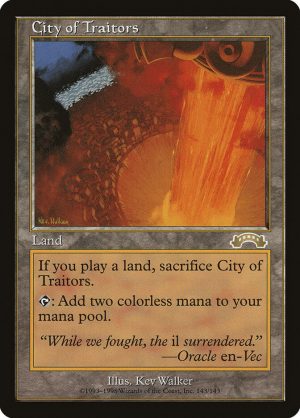
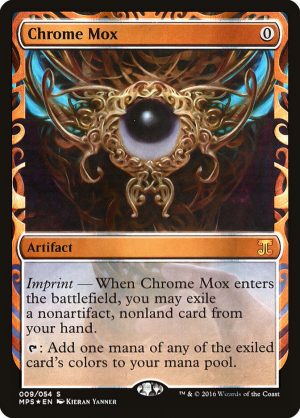

When specifically looking at White Plume Adventurer, the only 3 mana initiative threat, you might believe that such strong card was played in a variety of decks and not just stompy versions. But that was not really the case. Initiative threats to this day have exclusively been played in stompy decks only and been rather untouched by the remaining field. That’s one of the reasons, why the ban is even more surprising.
While Oko, Thief of Crowns had been legal for more than a year and was played in a variety of fair Legacy decks, White Plume Adventurer, arguably an inferior card than Oko, was axed in a rather fast pace from one archetype only. Once again, when reconsidering the massive meta share both Delver and Initiative were holding, the bans are understandable. Since Brainstorm and others seem to be untouchable for nostalgic and format identity reasons, they once again just banned the next big elephants in the room.
Conclusion
It was true that Legacy has been in an unhealthy state considering that Delver and Initiative were stifling any form of format development and innovation of the remaining decks.
But looking at all arguments being made, are Expressive Iteration and White Plume Adventurer really the correct targets or just scapegoats for larger and more structural problems Legacy is facing?
There are nostalgic reasons to play Legacy and the format should give the player base a way of playing with older Magic cards. The question is rather to what degree the preservation of old cards remains healthy and when it’s time to finally ban a fundament to let Legacy breath, open and evolve into a larger and healthier format overall. So far, the bans didn’t change the systematic problems the format is dealing with.


Brainstorm is still the best thing to do while Ancient Tomb makes sure the remaining initiative creatures are entering the board quickly. It feels like we as Legacy players are just waiting out on the next new hot thing to rule the format again, because the cards will be too good in combination with existing old cards; until they’re getting banned again.
The continuity of that ban cycle is like constantly walking on broken pieces of glass, always being careful and unsure about which new cards are being axed specifically for the sins of Brainstorm and Co.
The future will show how the format will end up, but as long as Brainstorm and to a lesser extend Ancient Tomb and Daze remain in the field, bans like Dreadhorde Arcanist, Expressive Iteration and White Plume Adventurer will happen frequently while the community is constantly confronted with unhealthy meta states.
Whether WotC and the community will deal with this unique format problem forever is unknown. But maybe this is what Legacy is about these days; never approaching its fundamental and structural problems, never trying to make the format healthier long term, but protecting old cards at all costs.
About the Author
My name is Sven Stolz, I’m 29 years young, and I’m trying to get my Master’s degree in business economics. I play competitive Magic since 2009.
Even as a kid, I was already fascinated by the old cards. When I was 17, I pretty quickly started to get into Legacy. Even though I had a few Magic-breaks through the years, I still managed to triumph in a few tournaments, most notably a win in the MKM Series Frankfurt 2019 as well as two Top 8 and one Top 32 placements during other MKM Series.
My all-time favorite decks are 2010 Extended Zoo and Legacy UR Delver. When I’m not playing Magic, I love to drive around on my motorcycle, and I also live vegan.
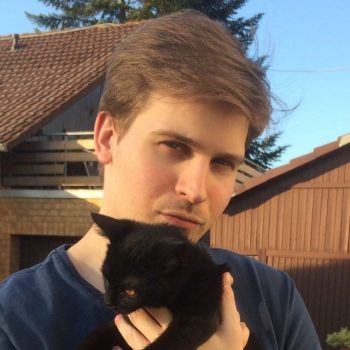
All Articles by Sven Stolz
Analysis on the March 2023 bans in MTG Legacy
In his latest article, Sven takes a closer look at the latest bannings in Legacy: Expressive Iteration and White Plume Adventurer. What follows are a historic analysis of the two beloved decks of the format, Izzet Delver and White Initiative, as well as a chronological evaluation of the most recent bannings in Legacy.
Best Cards in Modern – Multicolor [2022]
We asked our seasoned team of authors a tough question: What do they think are the best ten multicolored cards in Magic the Gathering's Modern format. We then went a step further and created a Top 5. Learn what they think about the very best cards of one of the game's most popular formats.
Best Cards in Modern – Lands [2022]
We asked our seasoned team of authors a tough question: What do they think are the best ten lands in Magic the Gathering's Modern format. We then went a step further and created a Top 5. Learn what they think about the very best cards of one of the game's most popular formats.
Best Cards in Modern – Artifacts [2022]
We asked our seasoned team of authors a tough question: What do they think are the best ten artifacts in Magic the Gathering's Modern format. We then went a step further and created a Top 5. Learn what they think about the very best cards of one of the game's most popular formats.
Best Cards in Modern – White [2022]
We asked our seasoned team of authors a tough question: What do they think are the best ten white cards in Magic the Gathering's Modern format. We then went a step further and created a Top 5. Learn what they think about the very best cards of one of the game's most popular formats.
Best Cards in Modern – Green [2022]
We asked our seasoned team of authors a tough question: What do they think are the best ten green cards in Magic the Gathering's Modern format. We then went a step further and created a Top 5. Learn what they think about the very best cards of one of the game's most popular formats.
Best Cards in Modern – Red [2022]
We asked our seasoned team of authors a tough question: What do they think are the best ten red cards in Magic the Gathering's Modern format. We then went a step further and created a Top 5. Learn what they think about the very best cards of one of the game's most popular formats.
Best Cards in Modern – Black [2022]
We asked our seasoned team of authors a tough question: What do they think are the best ten black cards in Magic the Gathering's Modern format. We then went a step further and created a top 5. Learn what they think about the very best cards of one of the game's most popular formats.
Best Cards in Modern – Blue [2022]
We asked our seasoned team of authors a tough question: What do they think are the best ten blue cards in Magic the Gathering's Modern format. We then went a step further and created a top 5. Learn what they think about the very best cards of one of the game's most popular formats.

